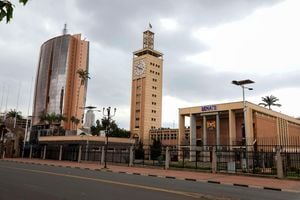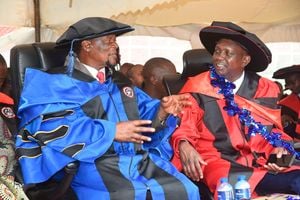PS: Kenya has red meat deficit of more than 250, 000 metric tonnes

John Ngatia cuts meat for customers at Springfield butchery in Nanyuki town in December 2017.
Kenya has a red meat deficit of more than 250,000 metric tonnes annually, Livestock Principal Secretary Jonathan Mueke has disclosed.
He said the annual national demand for red meat is 800,000 metric tonnes against production of 607,000 metric tonnes.
The PS said that livestock population estimates for the year 2021 showed that beef cattle were 16,182,356, sheep 24,801,605; goats 32,570,314 and camel 4,427,881, producing a combined 500,000 Metric tonnes of red meat in the year 2021
The annual per capita consumption is 15 kg of red meat.
“The country has a red meat deficit of more than 250 000 Metric tonnes; which continues to widen as demand for meat increases, courtesy of increasing population, urbanisation and rising incomes of the middle class,” said the PS in a speech read on his behalf by Dr Richard Kyuma a senior Livestock marketing officer in the department.
The PS said marketing for live animals and products provides the highest production incentive for greater investment at both the primary production level and value-added production.
Food security
Dr Kyuma read the PS speech in Naivasha during the African Pastoral Markets Development (APMD) platform sponsored by the African Union - Inter-African Bureau for Animal Resources (AU-IBAR).
The meeting was attended by pastoralists in the Arid and Semi-Arid counties of Kenya and other stakeholders in the livestock sector.
The AU-IBAR's mandate is to support the sustainable development and use of animal resources to improve food security and nutrition and to contribute to the prosperity and well-being of people in the African Union (AU) member states.
Dr Kyuma said one of the leading challenges in the pastoral production systems is the frequent occurrence of droughts, lack of markets for livestock products and disease occurrences like foot and mouth, skin, pneumonia and anthrax which bars pastoralists from exporting live animals and other animal products.
Quality fodder
However, he said the government is addressing some of these challenges through various interventions including the production of quality fodder, vaccination, compensating pastoralists through the use of insurance instruments and provision of water pans.
He admitted that the unavailability of good quality feeds for the animal at the right time and right quantities remains a big challenge to the livestock production system in Kenya.
“We have put interventions supporting livestock feed production at the commercial level to bridge the deficit. The government has given incentives including provisions of affordable credit facilities to livestock feed producers who are willing to produce feeds on a large scale for commercial purposes,” he added.
“Our ultimate goal is to target the European markets which are very lucrative but have strict safety standards,” he explained.
He said the government wants to involve women and youth to boost the sector that is dominated by men.
“Studies have shown that when women are well involved they do better than men in livestock business while the youth need to be occupied in the livestock sector by engaging them in business entities that connect with their aspirations.”





